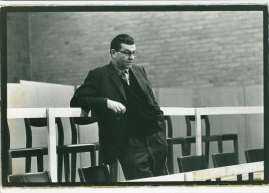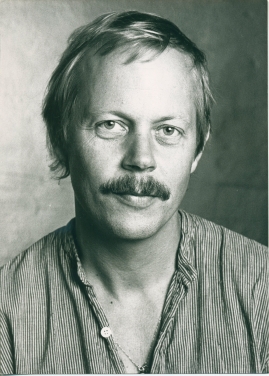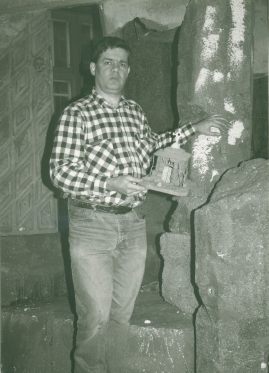Öyvind Fahlström
Table of contents
- Basic facts
- Links and resources
- Biography
- Awards
- Films
- Original work
- Soundtrack listing
- Groups
Basic facts
| Director |
|
|---|---|
| Screenplay |
|
| Show all films |
Biography
Swedish artist, author and filmmaker. Born as Öyvind Axel Christian Fahlström in São Paulo, Brazil. Died in Stockholm.-Öyvind Fahlström was one of the major and internationally most successful Swedish experimental artists of the 20th century. He worked as artist, poet, novelist, playwright as well as - for a few years in the sixties - filmmaker.He grew up in Brazil with a Norwegian father and a Swedish mother. In 1939 the ten year-old Öyvind spent the summer with relatives in Sweden, where his parents planned to join him...
Links and resources
Biography
Swedish artist, author and filmmaker. Born as Öyvind Axel Christian Fahlström in São Paulo, Brazil. Died in Stockholm.
-
Öyvind Fahlström was one of the major and internationally most successful Swedish experimental artists of the 20th century. He worked as artist, poet, novelist, playwright as well as - for a few years in the sixties - filmmaker.
He grew up in Brazil with a Norwegian father and a Swedish mother. In 1939 the ten year-old Öyvind spent the summer with relatives in Sweden, where his parents planned to join him soon. Their plans had to be postponed, however, due to the outbreak of World War II and it was not until eight years later that the family could be reunited in Stockholm. In 1949 Fahlström, by then a Swedish citizen, enrolled at the University of Stockholm to study art history and archaeology. Around this time he wrote his first screenplay, "Det här är ingen dröm" ('This Is Not a Dream') which he dedicated to the recently deceased French theatre artist Antonin Artaud.
Fahlström's early interest in film may seem surprising in light of his artistic preferences and usual choice of medium. The main reason for his fame abroad was his contributions to the American pop art scene and his working with such personages as Robert Rauschenberg, Claes Oldenburg and John Cage. His acclaimed installation "Dr. Schweitzer's Last Mission 1964-1965", shown at the Venice Biennale in 1966 added further international renown. In different periods he lived and worked in New York, Rome and Paris. Despite the fact that virtually everything he wrote was initially turned down by publishers, there is these days a consensus on his great importance as an avant-garde poet. Special significance is ascribed to his 1953 concrete poetry manifest entitled "Hipy Papy Bthutdhdth Thuthda Bthuthdy" ("Hätila ragulpr på fåtskliaben") which is often hailed as a pioneering work of the genre.
Fahlström had a long association with the medium of film. After This Is not a Dream he wrote several sketches for both cinema and television that likewise were never produced. From early on he took part in debates on the potential of experimental film and wrote articles in the evening paper Expressen, on Nordic filmmakers like Ingmar Bergman, Arne Sucksdorff and Carl Th. Dreyer. He also conducted interviews with Federico Fellini and François Truffaut. Fahlström's own film work is limited to the period of 1966-1969, a time of pronounced anti-establishment positioning when in his graphic art he addressed topics like the World Bank, the CIA, and the war in Vietnam.
Fahlström's first short, the five minute Mao-Hope March from 1966, although originally part of the performance installation "Kisses Sweeter than Wine" was later distributed as a separate work. In 1969 he made the two documentaries East Village and Revolution Now, the former about artists' life on Manhattan and the latter about protest groups in New York and culminating in the brutal police action against hippies demonstrating at the Democratic National Convention in Chicago that year.
Fahlström's short film U-Barn ('U-Children' or possibly 'U-Child'; a play on the word "u-land" meaning 'developing country'), also from the year 1968, is perhaps the film most clearly related to his other works of art, being a collage-like mixture of cinema verité, commercials, street theatre and drug-induced monologues. Furthermore it to some extent heralds the coming of Fahlström's only feature film, Du gamla, du fria (the title is the first line of the Swedish national anthem: 'Thou ancient, thou free'). This movie was harshly criticized, not to say panned completely, by reviewers. Though shot in 1969, it did not open at cinemas until two years later. Fahlström did not attend the opening, but communicated from New York that "As far as I am concerned this is now a historic film. It depicts a lively, confused era in the political left after the year of revolt 1968." With time, criticism of the film has become more benevolent; if for no other reason than recognition of its merit as an invaluable document of the time in which it was made.
Although he went on experimenting with a variety of art forms in the early seventies, after Du gamla, du fria Fahlström did no further film work. In these years he dealt mostly with current events in his art, the military coup in Chile, for instance, or the exposure of Swedish internal espionage by a secret intelligence agency within the armed forces. Following up on an idea by his recently deceased friend, writer Saul Gottlieb, Fahlström did however write the radio documentary, Cellen ('The Cell') in which cancer patients are interviewed about their lives. In 1976, at the age of 48, Öyvind Fahlström himself succumbed to the disease.
Krister Collin (2012)
(translated by James Schmale)
Films
| Director |
|
|---|---|
| Screenplay |
|
| Producer |
|
| Cast |
|
| Participant |
|



